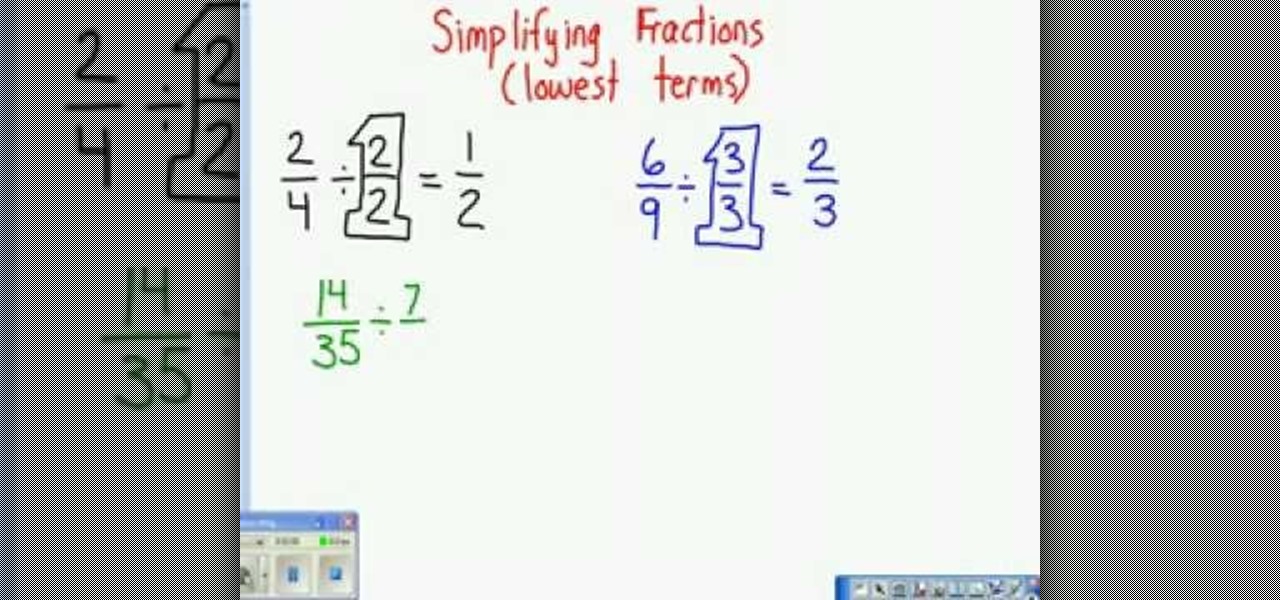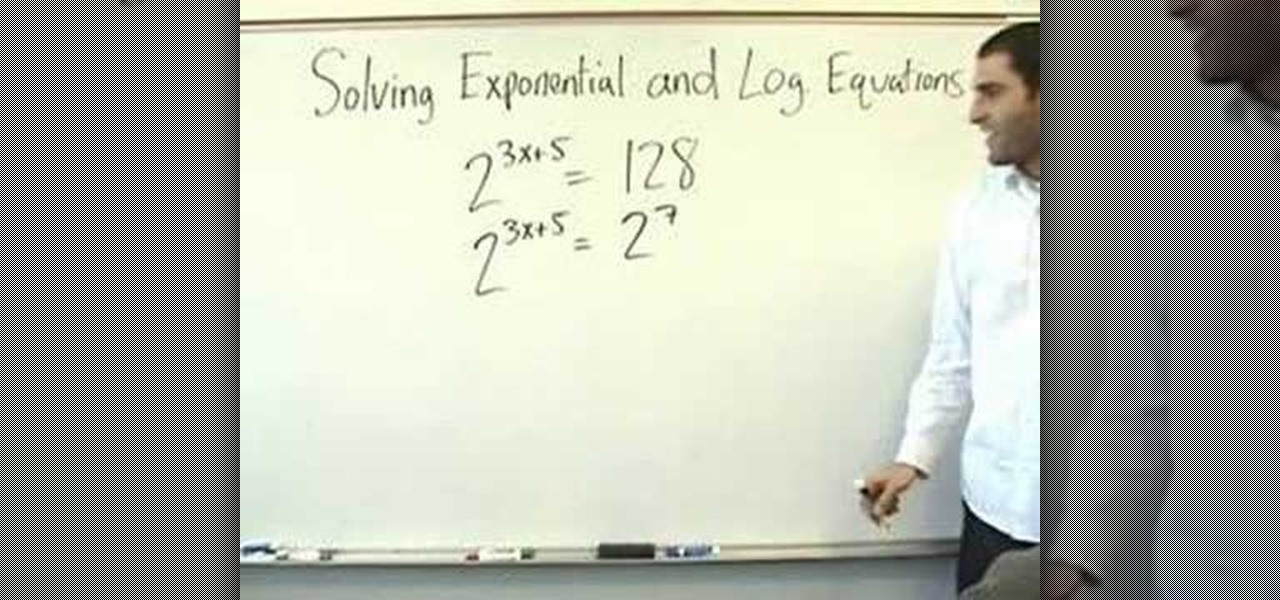
Long Term U Search Results


How To: Update from iOS 6 to iOS 7 on iPad Mini
Updating from iOS 6 to iOS 7 on the Apple iPad mini is as easy as opening the settings, tapping on Software Update, then pressing Install now and agreeing to the Terms and Conditions.

How To: Write a thesis statement
In this video, we learn how to write a thesis statement. What you really want to say about your topic is what the thesis statement is. It's nothing but your topic and what you want to say, so don't get scared by the term "thesis statement". Practice writing your paper using this saying instead of thinking of the thesis statement term. Usually in school you are given the topic you are going to write about it, so just state that topic and defend your position on it. It will be the same in real ...

How To: Solve multi-step equations with variables on both sides
This video is aimed at beginner level viewers and shows one of the basic techniques involved while solving linear equations having one variable.

How To: Understand equivalent fractions
In this video the instructor teaches about equivalent fractions. When given a problem to determine if two fractions are equivalent fractions the first thing to do is write them in the lowest terms. A fraction is said to be in the lowest terms if the greatest common divisor of both numerator and denominator is one. So cancel the common factors in the numerator and the denominator till you arrive at the lowest form and finally compare them to determine if they are equivalent. An equivalent frac...

How To: Pronounce the alphabet in Finnish
Finnish is an unusual language, which can make it tricky for foreigners to learn. Instead of relying on a book, the Learn Finnish video language-learning tutorial series shows a photograph of a vocabulary term while pronouncing the word in Finnish. This technique allows the student to associate the object itself, rather than the term in their native tongue, will the Finnish word, thus allowing for maximum comprehension and absorption. In this video segment, the alphabet, "aakoset" in Finnish,...

How To: Reduce fractions to their lowest terms
This video tutorial belongs to the Education category which is going to show you how to reduce fractions to their lowest terms. For doing any operation with fractions like addition, subtraction, multiplication or division, they need to be reduced to their lowest terms. To do this look at the numerator and the denominator and decide what number can divide both of them. Continue dividing till you can no more divide them. Now you get the lowest term of the fraction. For example, 2/4 can be divid...

How To: Write a thesis statement for an essay or paper
A thesis is the basis of any paper or essay. The thesis statement sets the tone and subject of your paper and starts you off on the right foot. In this tutorial, learn how to write an impressive thesis statement and get an A on your next paper!

How To: Learn How to Play the Market with This Data-Driven Trading Bundle
If you're reading this, you're likely a tech-savvy coding pro whose analytical talents are mostly applied to designing apps, cracking passwords, and infiltrating networks — all of which are admirable activities for both aspiring and seasoned white hat hackers. But there are other profitable ways that you can put these types of skills to use, namely in the world of investment and trading.

News: Microsoft FCC Filing Hints That the Wait for HoloLens 2 Is Almost Over
We know that Microsoft's HoloLens 2 is due to start shipping later this year, but despite the trickle of news about the device, we still don't know when.
News: Google Challenges Apple's iPhone X Series with Face Unlock & Air Gestures on Pixel 4
It's been almost two years since Apple added the TrueDepth depth-sensing camera of the iPhone X for Face ID and Animojis, but now Google is ready to upgrade the front-facing camera on its Pixel series.

Apple AR: Apple Smartglasses in Progress, Ready for the Public by 2020, Report Says
Like gas on an open flame, rumors and whispers have flared up in recent months around hopes of augmented reality smartglasses from Apple. But among all the false leads and unsubstantiated chatter, we finally have a credible report that some sort of Apple AR smartglasses are actually in development.
How To: Monitor Changes in Your Favorite Website's Terms of Service with Docracy's TOS Tracker
Every so often, a big site will make a change to its terms of service that's not so great for its users—without even informing them—and they (understandably) get really pissed off. Recent examples are Facebook's and Instagram's changes, which resulted in user backlash.

How To: Setup your HP TouchPad using the initial webOS wizard
If you were one of the lucky individuals to score a TouchPad before HP discountinued them, you will need to proceed through the initial setup wizard when you turn on the device for the first time, or after performing a data wipe and reset on the tablet. This guide will walk you through everything from accepting the terms & conditions, connecting to a Wi-Fi network, and creating a webOS account for the first time.

How To: Create an image gallery (slideshow) in Flash CS4
Slideshow is such a dirty word. Most people immediately think of boring family reunions or 1980's corporate meetings when they hear it. That's probably why web designers prefer using the term image gallery to refer to their slideshow-like works. This video will teach you how to make an automatic image gallery using Flash CS4, which is a slideshow where the images advance automatically on a timer.

How To: Breadboard a DIY USB power supply
While breadboarding may seem like some odd combination of snowboarding and consuming the fluffy pastry at the same time, it's actually just the technical term for using a construction base to build a prototype electric circuit. Breadboards are solderless so they're great for circuit design and are reusable.
News: President Obama goes to Afghanistan to sign post-war agreement
President Barack Obama and Afghan President Hamid Karzai signed an agreement that provides a framework for a lasting U.S. commitment to Afghanistan after the long and unpopular war comes to an end.

How To: 9 Tips for Maximizing Your Laptop's Battery Life
Whether you just got a brand new laptop or you've had an old notebook for several years, it's in your best interest to maximize your laptop battery life so you get the most out of your computer.

How To: Wrap your fists Muay Boran style for Muay Thai boxing
Muay Boran is the ancient relative of modern Muay Thai boxing. This clear how-to video shows the correct method of wrapping your fists to prepare for a match or training.

How To: Complete the square
Quadratic equations are easy to solve when they can be factorized. This video teaches another method of solving a quadratic equation when its not easy to find factors for it.

How To: Factor out when doing rational expressions in algebra
This video shows the method to simplify rational expressions. The example used in the video is multiple of 4 and x square plus multiple of 4 and x plus 1 or (4x^2 + 4x + 1)/(2x^3 + 11x^2 + 5x). As the first and last term is a perfect square we get the simplified numerator as (2x + 1)(2x + 1). Next, the denominator is simplified. Taking the common factor out we get x(2x^2 + 11x + 5). Now we factorize 2x^2 + 11x + 5. We get (2x + 1)(x + 5 ). Now, writing the terms in numerator and denominator w...

How To: Solve exponential and logarithmic equations
In this video tutorial the instructor shows how to solve exponential and logarithmic equations. Solving exponential equations can become very difficult if it involves large numbers. To solve these kinds of complex equations you need to get all the numbers to the same base number. The base number raised to some number should give you your original number. Now if you write the numbers as exponents of your base number you can directly equate the exponent part and solve for the missing variable. ...

How To: Factor a trinomial, GCF, then unfoil
In this video the instructor shows how to factor a polynomial. A polynomial having three terms is called as trinomial. Now if you factor it you will obtain two binomials whose product will be the original polynomial. Before factoring a polynomial you need to find out if the polynomial has a GCF. Look out for the common variables in all the three terms and pull them out which is the GCF of the polynomial. This simplifies the original equation to a polynomial which is of lower degree. Now facto...

How To: Use implicit differentiation to find a 2nd derivative
An educational video by http://JustMathTutoring.com that shows how to use implicit differentiation to find a 2nd derivative of an equation.

How To: Graph quadratic equations
In this video, the instructor shows you how to graph quadratic equations. When you have a quadratic equation in terms of x and y, first try to identify the coefficients of the terms. Now use front end of the quadratic formula to find the line of symmetry which is the first half of the vertex using the formula x = -b/2a. This gives the line of symmetry. Next, plot the line using a few points starting at the line of symmetry. Take sample values of x and find the corresponding values of y on eit...

How To: Solve word problems with proportions
In this video the instructor shows how to use proportions to solve fractions. When you have a proportions problem with an unknown term, cross multiply and divide it to get the value of that unknown term. For example if given 7/8 = m/4, cross multiply 7/8 with 4, giving 7/2 which is the value of the unknown variable m. So if two quantities are proportionate then you can equate them as shown in the video and cross multiply to get the value of any unknown variable. Proportions are just fractions...

How To: Factor trinomials in a very simple way
In this video, they demonstrate how to factor a trinomial. A trinomial is a polynomial with a quadratic term in the form, ax^2+bx+c. To factor this polynomial first multiply the a and c term. You must fine two numbers that multiply to a*c and add up to b. Once you have figured out the two numbers you place the two numbers (D and E for example) in the equation (1/a)(ax+D)(ax+E). It takes a bit of practice to be good at deciding what D and E are, but the best way is to make sure that D*E = a*c ...

How To: Solve percent equations
In this tutorial the instructor shows how to solve percent equations. The general form of a percent equations is that a is b% of c. As there can be three kinds of variables a, b, c, the questions involving percent equations can be of three types having one of the three variables unknown. These kind of percent statements can be solved easily by setting up an equation. So, to convert percent statement into a equation replace the unknown term with n, the 'is' term with equals sign and the '%' si...

How To: Solve rational equations
In this video the instructor shows how to solve rational equations. If you have fractions in your equation, then you need to factorize the denominators first. Now compute the least common denominator of all the denominators of the fraction. Next multiply both sides of the equation with the least common denominator. This cancels out all the denominators of all the fractions and you are left with a linear equation. Now simply multiply the remaining terms in the numerator and add common terms to...

How To: Find the equation of a circle given: center & tangent
In this video, the instructor shows how to find the equation of a circle given its center point and a tangent line to it. To do this, take a graph and plot the given point and the tangent on that graph. Now, from the center of the circle, measure the perpendicular distance to the tangent line. This gives us the radius of the circle. Using the center point and the radius, you can find the equation of the circle using the general circle formula (x-h)*(x-h) + (y-k)*(y-k) = r*r, where (h,k) is th...

How To: Divide rational expressions
In this video the instructor shows how to divide rational expressions. To divide rational expressions follow this simple four step approach. In the fist step change the division to multiplication by flipping the second fraction. Now the original division simplifies to multiplication. In the second step factor the terms of numerators and denominators in the two fractions. In the third step cancel the common terms in the numerator and the denominator. Now finally in the fourth step multiply all...

How To: Prove some random trigonometric identities
This video shows the method to prove some trigonometric identities. This involves the use of algebra and knowledge of basic trigonometric identities. The video demonstrates three examples to illustrate this problem and its solution. The first problem shows a relatively simple problem involving sines and cosines. The video shows some basic algebra steps to simplify the problem and prove the identities. The second example involves a slightly complicated problem involving square of combination o...

How To: Add & subtract fractions
This is a video that teaches how to add and subtract fractions. For fractions that have like denominators, you simply add the numerator and keep the denominator. Next, you reduce the fraction to its lowest term.

How To: Solve an equation by the distributive property
In this simple tutorial the tutor shows how to solve equation by the distributive property. He states that when there is a number which is multiplied to a full equation, we have to multiply each and every term of that equation by that multiplying number. This is called the distributive property as the value is distributed to each and every term inside the equation. He goes on and solves a problem based on this property to give a clear idea of the property. This video shows how to solve equati...

How To: Use the Common Factor factoring method
How to Use the Highest Common Factor method for Factoring

How To: Convert fractions to decimals easily
This video teaches you how to convert fraction to decimals in three easy steps. The process of decimal to fraction conversion involves the use of the fundamental rule of fractions; the fraction should be written in its lowest terms.

How To: Divide similar radicals
While dividing the radicals, the numerator and the denominator must be combined into a single term, for example if we want to divide square root of 3 by square root of seven we need to combine the numerator and denominator into a single factor that is square root of 3/7, then we can divide 3/7 which is 0.4285, and square root of 0.4285 is 0.654 which is the final answer.

How To: Understand Tagalog grammar terms
This how to video describes how to understand and use Tagalog grammar terms properly. The author suggests reading the book "Conversational Tagalog" to help increase your basic understanding of the language. He then covers the use of verbs and other grammatical devices in the Tagalog language. This video is perfect for those who are studying the Tagalog language or for those who need a quick refresher. The video lasts about eight and a half minuets and leaves you with a better understanding of...

How To: Utilize Zabernism bullying in World of WarCraft: Cataclysm (PvP battlegrounds)
Zabernism. What exactly is it? It's a term that originated in 1912, during an incident involving an overzealous soldier who killed a cobbler for smiling at him is Saverne, a small town in Alsace in north-eastern France. The said event ultimately triggered an intervention from the army who took over the power from local authorities.

News: North Cuts Employees After Slicing Price of Focals Smartglasses
A week after reducing the base price of its Focals smartglasses by nearly 50 percent, wearables maker North is now reducing its workforce.

